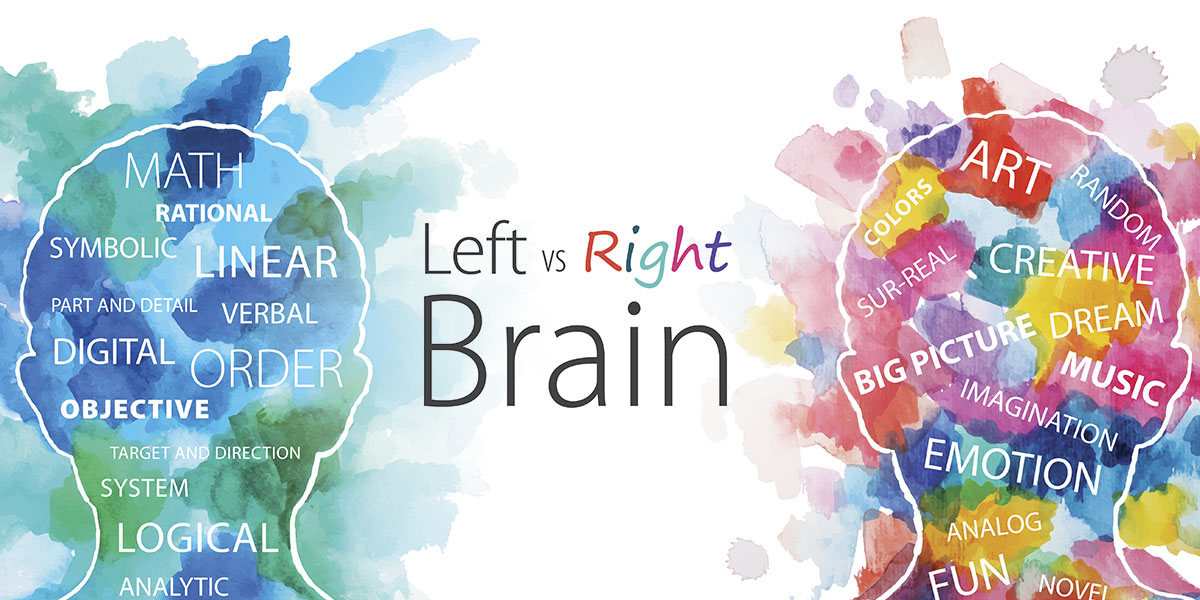Let’s face it, data is data—it is black and white.
Scientific determinations are, of course, useful in marketing and advertising, but do not necessarily mean a connection will be formed with an end user. Conversely, the application of human creative skill and imagination can also not be considered a standalone factor as it relates to the success of an advertising or marketing campaign. Just because something appears artful doesn’t mean it will resonate with a targeted audience or elicit a response.
In order for emotional marketing initiatives to be successful, art and science need to be blended when formulating a campaign—and a balance must be struck.
Right Brain, Left Brain, or Both?
Think of the human brain with its two hemispheres. The right side of the brain functions from an artistic and theoretical perspective, with decision making processes based on feeling and intuition. It is the storyteller that captures hearts and minds, creating connections.
The left brain, then, is the scientist who makes decisions based on facts, data, and evidence. It is the problem solver and the planner who values accuracy, analysis, and personalization.
With those distinctions made, and for the sake of emotional marketing, know that both proficiencies are required. Data must be present to enlighten and inform “The Creative”—the ultimate tangible output that results. In turn, this builds upon that information to understand who and where the audience is, how they consume media, and how emotion and connection are spurred. Ideally, this leads to an action being taken, a response.
The data serves as a paintbrush, it enables the result to be achieved, but it isn’t responsible for the vision itself.
Deep Dive Discovery Powers the Science
This is a necessary start in any emotional marketing campaign. In our work, we have had clients literally send reams and reams of paper and a plethora of internal and external information, communications, and data about their business, goals, and objectives. Emotional marketing cannot be accomplished without intensive research and discovery.
Here are essential questions to address:
- Who is your customer?
- What does your customer value?
- What does your customer need?
- What are your customers’ pain points?
- Who are you as an organization?
- How does your organization or your product address your customers’ needs?
- How does your organization or product fail to meet your customers’ needs?
- What is your vision, and does it connect with a customer? (Be honest!)
This part of the process is incredibly important. Don’t skip due diligence and don’t make assumptions. What’s more, be objective and take your ego out of it. Employ a different lens, pretend you are the customer.
Using Research & Data to Inform Creative Messaging
It is very common for a marketer or advertiser to focus on targeting specific audiences based on the right algorithms and data, but neglect to place importance on the creative and storytelling elements of the campaign. And frankly, one might believe they will get results from this approach—and they may, just a bit—but the campaign will not live up to its full potential or deliver comprehensive ROI.
Creativity or “The Creative Outcome” must be optimized and based on the data—and silos must be eliminated between the practices. Marketers must find a balance between data insights and innovative creative, and when this is achieved, confidence in execution grows from one campaign to the next.
Targeting Emotions & Striking a Chord with Customers
The goal, ultimately, of realizing equilibrium between the data and the creative process is to execute a campaign that delivers a strong and empathetic brand message that resonates with a potential customer and triggers the motivation and desire to act.
Explaining how good a product or service is doesn’t cut it these days, emotions are primary and come first. And emotions are how you create a brand impression that moves a potential customer out of their comfort zone, inspires them to try a new product or service, and builds affinity that has the power to last for the long haul.
Think about it a bit deeper in this regard… certain words, colors, shapes, and images connect in completely different ways. For instance, an all-lowercase, rounded font implies friendly and welcoming humbleness, whereas all capital or bold letterforms send a commanding, assertive message. Rounded shapes, as in a logo, invoke a softer, warmer feeling, while angles and hard edges deliver a self-assured decided firm feeling.
There are many different iterations with that.
Now, let’s consider colors, which also affect the psyche. A bold, warm red or orange delivers a completely different message than a cool blue or green. Words are similar too, in that selection as well as writing style can completely change the impact a message makes. The selection of adjectives and verbs is key, as well as the person or voice perspective you are talking or writing in.
“Professional” designers and writers understand the nuances of content delivery. Their importance to the branding process should never be diminished. Often, I have a client insist, “We’ll write it ourselves” or “We have someone who just learned InDesign.” Ninety-nine percent of the time this is a huge mistake.
After all, anyone can play Chopsticks on a piano, but it will never affect the listener like Chopin. The same is true of design. Any layperson can dabble with a program, but the lack of design theory, color understanding, and composition will be obvious and more importantly, it will be felt by the viewer, listener, or reader. One can never fall short in any of these areas when building a brand.
A Brand Must Care About Their Target Market
It all comes back to this: A brand is what everyone perceives it to be, and perception is reality.
For emotional marketing to work, then, the brand itself must care about their target market—their customers who hopefully have the unified perception—before anything else. That desire is what is going to fuel your efforts to sort and understand that data, first, and then turn it into a story and imagery that connects.
Realize, too, that the emotions you aim to generate don’t necessarily have to begin or end with happiness—truly depending on your audience, product, and industry, you have to dig deep and understand what you are trying to elicit. Rather, other emotions like fear, anger, guilt, as well as serenity, love, and belonging can all drive action, encourage sales of a product or service, and expand revenue streams exponentially.
And You Must Have a Multi-Disciplinary Team
There are few people who can use both sides of their brain simultaneously, so that means the makeup of your team matters in order deploy emotional marketing strategy that works. You must build a team that encompasses both right-brain and left-brain skills, effectively communicate, and embrace and mix ideas from multiple disciplines, including psychology, computer science, neuroscience, sociology, economics and statistics, anthropology…and even understand something like color theory!
Your team must comprise of Artists and Scientists and cross-learning must be encouraged at all points of an engagement.
A final point is that you must have the right talent, tools, technology, and processes in place and be able to analyze both hard and soft metrics. All of this combined has the potential to support synergy between the data and the ideas, the art and the science, and make your advertising and marketing initiatives that much more impactful, memorable, and most importantly… authentically human.
Sagon-Phior has successfully applied this unique practice to many national and global brands in technology, healthcare, banking, lifestyle and non-profit categories. For more information, go to Sagon-Phior.com









